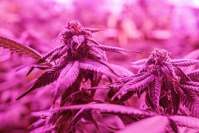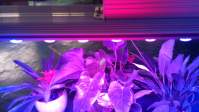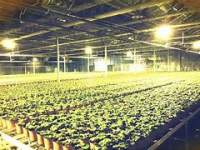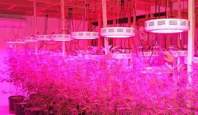The effect of LED plant light quality on indoor crops
The light quality of LED plants affects the growth of indoor crop roots. Light can pass through the internal light environment, through the regulation of photoreceptors, and regulate their growth and development. Although there is no direct light, the response to different light quality is also different. The blue light of LED plant lights is conducive to the growth and development of plant roots. Blue light can increase the root vigor, total absorption area and active absorption area of seedlings. The cultivated rice seedlings were irradiated with the blue light of the LED plant light, and it was found that the protein content accumulated in the root system of the rice seedlings was high, the non-protein nitrogen content was low, the ratio of protein nitrogen to total nitrogen was high, and the total nitrogen content was also high. The synthesis of nitrogen compounds in the root system of the seedlings, the production of protein accumulates in the root system. Seedling raising based on the blue light effect of LED plant lights on crop roots has been applied by reproducers.
The effect of LED plant light quality on the growth of indoor crop leaves, leaves are the main organs for photosynthesis of plants, and the change of LED plant light quality directly affects leaf growth. According to reports, the leaf area of birch seedlings grown under blue light is twice that of seedlings under red light, and the area of leaf epidermal cells, palisade tissue, sponge tissue and functional chloroplasts are larger than those under white and red light. The rice seedling experiment has the same result. Compared with white light, blue light can obviously promote the growth of rice seedling leaves, increase the angle between the leaf and the sheath, and make the leaves flat; while the effect of red light is opposite, it inhibits the increase of leaves. Wide growth. However, some people think that the compound light is more conducive to the growth and development of the leaves. The leaf area of lettuce under the combination of red, blue, and green light is extremely large, followed by white light, and red and blue light. Studies have also shown that increasing the proportion of LED red light in the compound light has a certain promotion effect on the increase of tobacco leaf area, but the leaf weight of the leaf is reduced, and the leaf becomes very thin.
The effect of the light quality of the LED plant light on the growth of indoor crop stems. Different wavelengths of light can regulate the growth of the stems by affecting the level of endogenous hormones in the plant. Blue-violet light can increase the activity of indole acetic acid oxidase and reduce the level of auxin, thereby inhibiting the growth of plants. At the molecular structure level, red light can promote cell elongation, while blue light has the opposite effect. The long-wavelength LED plant light red light promotes the elongation of the stem, while the short-wavelength light inhibits the elongation of the stem.
The effect of LED plant light spectrum on indoor crops
UV spectrum (100–400 nm)
The ultraviolet spectrum that is invisible to the human eye is outside the PAR range (100nm-400nm). Approximately 10% of sunlight is ultraviolet light. Just like humans, plants can be harmed by excessive exposure to ultraviolet light. Divided into 3 types, UV-A (315-400 nm), UV-B (280-315 nm) and UV-C (100-280 nm).Although the benefits of using ultraviolet light in indoor cultivation are still being researched, ultraviolet light usually leads to a deeper purple-in fact, a small amount of ultraviolet light can have a beneficial effect on color, nutritional value, taste and aroma.Studies have shown that using controlled amounts of ultraviolet light can also reduce environmental stress, fungi and pests. Studies have shown that the use of UV-B light (280 nanometers to 315 nanometers) can increase the cannabinoids such as tetrahydrocannabinol in cannabis.
Blue light spectrum (400–500 nm)
The blue light spectrum is widely responsible for improving plant quality—especially in leaf crops. It promotes stomata opening-allowing more carbon dioxide to enter the leaves. Blue light drives the peak absorption of chlorophyll pigments required for photosynthesis.This is essential for seedlings and seedlings in the vegetative stage, as they will establish a healthy root and stem structure-especially important when stem extension must be reduced.
Green light spectrum (500–600 nm)
Compared with the red or blue spectrum, the green wavelength is less important for plant photosynthesis because it (not) easily absorbs chlorophyll. Nevertheless, green is still absorbed and used for photosynthesis. In fact, only 5-10% is actually reflected-the rest is absorbed or transmitted to a lower place! This is because green light can penetrate the canopy of plants,In the greenhouse, due to the presence of sunlight, the use of LED grow lights to supplement the green light spectrum is less important than crops that are only grown indoors (such as hemp or vertical crop cultivation).
Red light spectrum (600–700 nm)
Red light is the most effective spectrum for promoting photosynthesis because it is highly absorbed by chlorophyll pigments. In other words, it is located at the peak of chlorophyll absorption. The wavelength of red light (especially around 660nm) promotes the growth of stems, leaves and general vegetative growth-but the most common is the tall extension of leaves and flowers.It must be balanced with blue light to counteract any excessive stretching, such as deformed stem elongation. It is important to consider that although red is the most sensitive spectrum to plants, its efficacy will really come into play when combined with other PAR wavelengths.
Far-red light spectrum (700-850 nm)
Far-red affects plant growth in several ways-one is to initiate the shade avoidance response. At about 660nm (dark red), plants will feel bright sunlight. From 730 nanometers and above-that is, the ratio of far red light to red light is higher, the plant will detect the light "shadow" from another plant or a leaf higher in the canopy, so stem and leaf stretching will occur.
Far-red is very useful for promoting flowering and can increase fruit yield in some plants. In short-day plants like cannabis that rely on longer periods of darkness, 730nm can be used at the end of the photoperiod to promote flowering. Many growers are trying to use bursts of red light to interrupt the cycle of darkness to promote growth and flowering.






